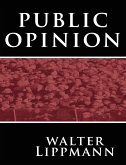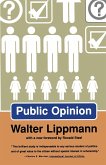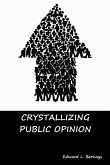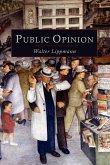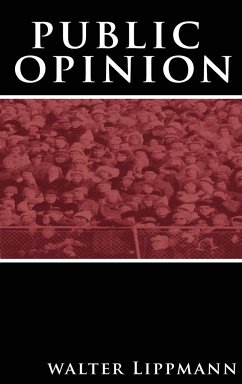- Gebundenes Buch
- Merkliste
- Auf die Merkliste
- Bewerten Bewerten
- Teilen
- Produkt teilen
- Produkterinnerung
- Produkterinnerung
Public Opinion: Measuring the American Mind provides an in-depth look at the history and future of polling, including how public opinion is measured, how it is used and misused, and how to critically evaluate public opinion data. This new edition incorporates a new theme of political polarization and examines how mass media and social media help to shape public opinion. It also provides in-depth coverage of public opinion on such issues as political ideology, health care, race, and foreign policy, as well as an update and discussion of the major changes that have taken place on controversial issues such as gay marriage, gun control, and immigration.…mehr
Andere Kunden interessierten sich auch für
![Public Opinion Public Opinion]() Barbara A. BardesPublic Opinion120,99 €
Barbara A. BardesPublic Opinion120,99 €![Public Opinion Public Opinion]() Walter LippmannPublic Opinion14,99 €
Walter LippmannPublic Opinion14,99 €![Public Opinion Public Opinion]() Walter LippmannPublic Opinion20,99 €
Walter LippmannPublic Opinion20,99 €![Crystallizing Public Opinion Crystallizing Public Opinion]() Edward L. BernaysCrystallizing Public Opinion15,99 €
Edward L. BernaysCrystallizing Public Opinion15,99 €![Public Opinion Public Opinion]() Walter LippmannPublic Opinion16,99 €
Walter LippmannPublic Opinion16,99 €![Crystallizing Public Opinion Crystallizing Public Opinion]() Edward BernaysCrystallizing Public Opinion20,99 €
Edward BernaysCrystallizing Public Opinion20,99 €![Public Opinion Public Opinion]() Walter LippmannPublic Opinion25,99 €
Walter LippmannPublic Opinion25,99 €-
-
-
Public Opinion: Measuring the American Mind provides an in-depth look at the history and future of polling, including how public opinion is measured, how it is used and misused, and how to critically evaluate public opinion data. This new edition incorporates a new theme of political polarization and examines how mass media and social media help to shape public opinion. It also provides in-depth coverage of public opinion on such issues as political ideology, health care, race, and foreign policy, as well as an update and discussion of the major changes that have taken place on controversial issues such as gay marriage, gun control, and immigration.
Hinweis: Dieser Artikel kann nur an eine deutsche Lieferadresse ausgeliefert werden.
Hinweis: Dieser Artikel kann nur an eine deutsche Lieferadresse ausgeliefert werden.
Produktdetails
- Produktdetails
- Verlag: Rowman & Littlefield Publishers
- Fifth Edition
- Seitenzahl: 372
- Erscheinungstermin: 25. März 2016
- Englisch
- Abmessung: 235mm x 157mm x 26mm
- Gewicht: 754g
- ISBN-13: 9781442261877
- ISBN-10: 1442261870
- Artikelnr.: 44215603
- Herstellerkennzeichnung
- Libri GmbH
- Europaallee 1
- 36244 Bad Hersfeld
- gpsr@libri.de
- Verlag: Rowman & Littlefield Publishers
- Fifth Edition
- Seitenzahl: 372
- Erscheinungstermin: 25. März 2016
- Englisch
- Abmessung: 235mm x 157mm x 26mm
- Gewicht: 754g
- ISBN-13: 9781442261877
- ISBN-10: 1442261870
- Artikelnr.: 44215603
- Herstellerkennzeichnung
- Libri GmbH
- Europaallee 1
- 36244 Bad Hersfeld
- gpsr@libri.de
By Barbara A. Bardes and Robert W. Oldendick
PART I: PUBLIC OPINION AND AMERICAN DEMOCRACY 1. Public Opinion and
American Democracy Defining Public Opinion Does Public Opinion Matter?
Public Opinion versus Public Judgment Opinions, Attitudes, and Beliefs The
Current Environment The Plan of the Book 2. Measuring American Opinion: The
Origins of Polling The Origins of Public Opinion Polling The Development of
Survey Research The Election of 1948: A Temporary Setback After 1948:
Continued Growth A Surge in Telephone Interviewing: The Development of
Random-Digit Dialing The Rise of Internet Polling Social Media as an
Indicator of Public Opinion PART II: HOW ARE OPINIONS MEASURED AND USED? 3.
How Public Opinion Data Are Used Using Public Opinion in Political
Campaigns The Use of Public Opinion Polling by Officeholders The Use of
Polling Data by Government Agencies Public Opinion and Interest Groups The
Use of Polling by the Media Tracking Presidential Approval Ratings The
Call-In Poll The Use of Public Opinion Data in Academic Research 4. How Are
Opinions Measured? Modes of Survey Data Collection Populations of Interest
Selecting a Sample Random-Digit Dialing Sampling for Electronic Data
Collection Sampling Error Sample Size Non-probability Sampling
Questionnaire Design Data Analysis PART III: WHAT DO AMERICANS BELIEVE? 5.
Sources of Opinions: Socialization, Mass Media, and Social Media The
Political Learning of Children and Adolescents The Influence of Formal
Education Gender and Opinions The Influence of Peers Generational
Influences on Opinion The Role of Genetics in Shaping Opinions How Mass
Media Influences Public Opinion Social Media and the Formation of Opinion
6. What the Public Knows about Politics Early Empirical Investigations The
Unchanging American Voter Applying Democratic Principles Group Differences
in Knowledge The Consequences of Political Knowledge A Glass Half-Full
Perspective? 7. Political Orientations Political Ideology Party
Identification Confidence in Institutions Trust in Government Polarization
and Party Sorting in the American Electorate 8. Public Opinion on
Social-Welfare Issues Social-Welfare Issues Social Security Education
Health Care Assisting the Needy The Environment The Issue of Global Warming
Group Differences in Attitudes Polarization on Social-Welfare Issues 9.
Americans' Views on Racial Issues Historical Racial Issues Government Aid
to Minority Groups Affirmative Action Symbolic Racism Differences is the
Racial Attitudes of Blacks and Whites Polarization on Racial Issues The
Increasing Influence of Hispanics 10. Public Opinion on Highly
Controversial Issues Public Opinion toward Abortion Public Opinion on Gay
Rights The Politics of Individual Rights Privacy and the Patriot Act The
Politics of Crime and Criminal Justice American Views on Gun Control
Thinking about Weapons and Government Controls Immigration: A Mind Divided
Polarization on Controversial Issues 11. How Americans View Foreign and
Defense Policies American Opinion in the Post 9/11 World Public Opinion and
Foreign Policy: Which Opinions? Foreign Policy Goals and Priorities Issues
of War and Peace Terrorism and the Wars in Afghanistan and Iraq
Peacekeeping, Rescue, and Other Uses of Military Force Foreign Aid and
Other International Issues How Do Americans Think about Foreign Policy?
Polarization on Foreign Policy Issues PART IV: PUBLIC OPINION AND VOTING
12. The Electoral Connection: Public Opinion and the Vote Polls and
Elections How Voters Decide The Connection between Opinions on Issues and
the Vote The Role of Political Parties in Elections Political Ideology and
the Vote Party Polarization and Voting Behavior
American Democracy Defining Public Opinion Does Public Opinion Matter?
Public Opinion versus Public Judgment Opinions, Attitudes, and Beliefs The
Current Environment The Plan of the Book 2. Measuring American Opinion: The
Origins of Polling The Origins of Public Opinion Polling The Development of
Survey Research The Election of 1948: A Temporary Setback After 1948:
Continued Growth A Surge in Telephone Interviewing: The Development of
Random-Digit Dialing The Rise of Internet Polling Social Media as an
Indicator of Public Opinion PART II: HOW ARE OPINIONS MEASURED AND USED? 3.
How Public Opinion Data Are Used Using Public Opinion in Political
Campaigns The Use of Public Opinion Polling by Officeholders The Use of
Polling Data by Government Agencies Public Opinion and Interest Groups The
Use of Polling by the Media Tracking Presidential Approval Ratings The
Call-In Poll The Use of Public Opinion Data in Academic Research 4. How Are
Opinions Measured? Modes of Survey Data Collection Populations of Interest
Selecting a Sample Random-Digit Dialing Sampling for Electronic Data
Collection Sampling Error Sample Size Non-probability Sampling
Questionnaire Design Data Analysis PART III: WHAT DO AMERICANS BELIEVE? 5.
Sources of Opinions: Socialization, Mass Media, and Social Media The
Political Learning of Children and Adolescents The Influence of Formal
Education Gender and Opinions The Influence of Peers Generational
Influences on Opinion The Role of Genetics in Shaping Opinions How Mass
Media Influences Public Opinion Social Media and the Formation of Opinion
6. What the Public Knows about Politics Early Empirical Investigations The
Unchanging American Voter Applying Democratic Principles Group Differences
in Knowledge The Consequences of Political Knowledge A Glass Half-Full
Perspective? 7. Political Orientations Political Ideology Party
Identification Confidence in Institutions Trust in Government Polarization
and Party Sorting in the American Electorate 8. Public Opinion on
Social-Welfare Issues Social-Welfare Issues Social Security Education
Health Care Assisting the Needy The Environment The Issue of Global Warming
Group Differences in Attitudes Polarization on Social-Welfare Issues 9.
Americans' Views on Racial Issues Historical Racial Issues Government Aid
to Minority Groups Affirmative Action Symbolic Racism Differences is the
Racial Attitudes of Blacks and Whites Polarization on Racial Issues The
Increasing Influence of Hispanics 10. Public Opinion on Highly
Controversial Issues Public Opinion toward Abortion Public Opinion on Gay
Rights The Politics of Individual Rights Privacy and the Patriot Act The
Politics of Crime and Criminal Justice American Views on Gun Control
Thinking about Weapons and Government Controls Immigration: A Mind Divided
Polarization on Controversial Issues 11. How Americans View Foreign and
Defense Policies American Opinion in the Post 9/11 World Public Opinion and
Foreign Policy: Which Opinions? Foreign Policy Goals and Priorities Issues
of War and Peace Terrorism and the Wars in Afghanistan and Iraq
Peacekeeping, Rescue, and Other Uses of Military Force Foreign Aid and
Other International Issues How Do Americans Think about Foreign Policy?
Polarization on Foreign Policy Issues PART IV: PUBLIC OPINION AND VOTING
12. The Electoral Connection: Public Opinion and the Vote Polls and
Elections How Voters Decide The Connection between Opinions on Issues and
the Vote The Role of Political Parties in Elections Political Ideology and
the Vote Party Polarization and Voting Behavior
PART I: PUBLIC OPINION AND AMERICAN DEMOCRACY 1. Public Opinion and
American Democracy Defining Public Opinion Does Public Opinion Matter?
Public Opinion versus Public Judgment Opinions, Attitudes, and Beliefs The
Current Environment The Plan of the Book 2. Measuring American Opinion: The
Origins of Polling The Origins of Public Opinion Polling The Development of
Survey Research The Election of 1948: A Temporary Setback After 1948:
Continued Growth A Surge in Telephone Interviewing: The Development of
Random-Digit Dialing The Rise of Internet Polling Social Media as an
Indicator of Public Opinion PART II: HOW ARE OPINIONS MEASURED AND USED? 3.
How Public Opinion Data Are Used Using Public Opinion in Political
Campaigns The Use of Public Opinion Polling by Officeholders The Use of
Polling Data by Government Agencies Public Opinion and Interest Groups The
Use of Polling by the Media Tracking Presidential Approval Ratings The
Call-In Poll The Use of Public Opinion Data in Academic Research 4. How Are
Opinions Measured? Modes of Survey Data Collection Populations of Interest
Selecting a Sample Random-Digit Dialing Sampling for Electronic Data
Collection Sampling Error Sample Size Non-probability Sampling
Questionnaire Design Data Analysis PART III: WHAT DO AMERICANS BELIEVE? 5.
Sources of Opinions: Socialization, Mass Media, and Social Media The
Political Learning of Children and Adolescents The Influence of Formal
Education Gender and Opinions The Influence of Peers Generational
Influences on Opinion The Role of Genetics in Shaping Opinions How Mass
Media Influences Public Opinion Social Media and the Formation of Opinion
6. What the Public Knows about Politics Early Empirical Investigations The
Unchanging American Voter Applying Democratic Principles Group Differences
in Knowledge The Consequences of Political Knowledge A Glass Half-Full
Perspective? 7. Political Orientations Political Ideology Party
Identification Confidence in Institutions Trust in Government Polarization
and Party Sorting in the American Electorate 8. Public Opinion on
Social-Welfare Issues Social-Welfare Issues Social Security Education
Health Care Assisting the Needy The Environment The Issue of Global Warming
Group Differences in Attitudes Polarization on Social-Welfare Issues 9.
Americans' Views on Racial Issues Historical Racial Issues Government Aid
to Minority Groups Affirmative Action Symbolic Racism Differences is the
Racial Attitudes of Blacks and Whites Polarization on Racial Issues The
Increasing Influence of Hispanics 10. Public Opinion on Highly
Controversial Issues Public Opinion toward Abortion Public Opinion on Gay
Rights The Politics of Individual Rights Privacy and the Patriot Act The
Politics of Crime and Criminal Justice American Views on Gun Control
Thinking about Weapons and Government Controls Immigration: A Mind Divided
Polarization on Controversial Issues 11. How Americans View Foreign and
Defense Policies American Opinion in the Post 9/11 World Public Opinion and
Foreign Policy: Which Opinions? Foreign Policy Goals and Priorities Issues
of War and Peace Terrorism and the Wars in Afghanistan and Iraq
Peacekeeping, Rescue, and Other Uses of Military Force Foreign Aid and
Other International Issues How Do Americans Think about Foreign Policy?
Polarization on Foreign Policy Issues PART IV: PUBLIC OPINION AND VOTING
12. The Electoral Connection: Public Opinion and the Vote Polls and
Elections How Voters Decide The Connection between Opinions on Issues and
the Vote The Role of Political Parties in Elections Political Ideology and
the Vote Party Polarization and Voting Behavior
American Democracy Defining Public Opinion Does Public Opinion Matter?
Public Opinion versus Public Judgment Opinions, Attitudes, and Beliefs The
Current Environment The Plan of the Book 2. Measuring American Opinion: The
Origins of Polling The Origins of Public Opinion Polling The Development of
Survey Research The Election of 1948: A Temporary Setback After 1948:
Continued Growth A Surge in Telephone Interviewing: The Development of
Random-Digit Dialing The Rise of Internet Polling Social Media as an
Indicator of Public Opinion PART II: HOW ARE OPINIONS MEASURED AND USED? 3.
How Public Opinion Data Are Used Using Public Opinion in Political
Campaigns The Use of Public Opinion Polling by Officeholders The Use of
Polling Data by Government Agencies Public Opinion and Interest Groups The
Use of Polling by the Media Tracking Presidential Approval Ratings The
Call-In Poll The Use of Public Opinion Data in Academic Research 4. How Are
Opinions Measured? Modes of Survey Data Collection Populations of Interest
Selecting a Sample Random-Digit Dialing Sampling for Electronic Data
Collection Sampling Error Sample Size Non-probability Sampling
Questionnaire Design Data Analysis PART III: WHAT DO AMERICANS BELIEVE? 5.
Sources of Opinions: Socialization, Mass Media, and Social Media The
Political Learning of Children and Adolescents The Influence of Formal
Education Gender and Opinions The Influence of Peers Generational
Influences on Opinion The Role of Genetics in Shaping Opinions How Mass
Media Influences Public Opinion Social Media and the Formation of Opinion
6. What the Public Knows about Politics Early Empirical Investigations The
Unchanging American Voter Applying Democratic Principles Group Differences
in Knowledge The Consequences of Political Knowledge A Glass Half-Full
Perspective? 7. Political Orientations Political Ideology Party
Identification Confidence in Institutions Trust in Government Polarization
and Party Sorting in the American Electorate 8. Public Opinion on
Social-Welfare Issues Social-Welfare Issues Social Security Education
Health Care Assisting the Needy The Environment The Issue of Global Warming
Group Differences in Attitudes Polarization on Social-Welfare Issues 9.
Americans' Views on Racial Issues Historical Racial Issues Government Aid
to Minority Groups Affirmative Action Symbolic Racism Differences is the
Racial Attitudes of Blacks and Whites Polarization on Racial Issues The
Increasing Influence of Hispanics 10. Public Opinion on Highly
Controversial Issues Public Opinion toward Abortion Public Opinion on Gay
Rights The Politics of Individual Rights Privacy and the Patriot Act The
Politics of Crime and Criminal Justice American Views on Gun Control
Thinking about Weapons and Government Controls Immigration: A Mind Divided
Polarization on Controversial Issues 11. How Americans View Foreign and
Defense Policies American Opinion in the Post 9/11 World Public Opinion and
Foreign Policy: Which Opinions? Foreign Policy Goals and Priorities Issues
of War and Peace Terrorism and the Wars in Afghanistan and Iraq
Peacekeeping, Rescue, and Other Uses of Military Force Foreign Aid and
Other International Issues How Do Americans Think about Foreign Policy?
Polarization on Foreign Policy Issues PART IV: PUBLIC OPINION AND VOTING
12. The Electoral Connection: Public Opinion and the Vote Polls and
Elections How Voters Decide The Connection between Opinions on Issues and
the Vote The Role of Political Parties in Elections Political Ideology and
the Vote Party Polarization and Voting Behavior



